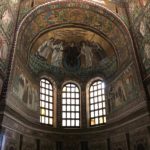Urbino to Ravenna – 135 km (train & bus) &
16,112 & 1 day 11,804 Fit Bit steps
Ravenna’s eight listings as UNESCO World Heritage Sites recognize the city’s unique collection of early Christian mosaics and monuments, dating back to the 5th to 8th centuries. As capital of the Western Holy Roman Empire and later, the Eastern (Byzantine) Holy Roman Empire, the mosaics and buildings constructed during this time have added significance due to the blending of western and eastern motifs and techniques representative of that era. We were awed and fascinated by the outstanding quality of the colourful detailed religious and funerary images, from the small Neonian Baptistry to the grand Basilica of San Vitale. It was sobering to go into the Church of San Giovanni Evangelista to find partially reconstructed mosaics recovered after the building was almost totally destroyed in a Allied bombing raid in 1944.
We also experienced a lively modern day Ravenna as there was a wine and food festival on. Booths in a number of plazas showcased Sangiovese and Romagna’s other wines, cheeses and street food, such as the delicious piadina – a thin Italian flatbread, typically prepared in the Romagna historical region, which can be filled with cheese, meats or vegetables. We enjoyed more local cuisine at an enoteca and restaurant, Ca’ de Vèn, recommended by our B&B, which was so good we ate there twice.













Hi Lois and Paul
Good to see you on the road again even if you are not on your bikes yet. Have been enjoying reading your blog again. We are feeling inspired by your route along the Italian coast on foot. We were there in 1985 with Brian’s father, enroute back to his village in Calabria, but travelling by car. How nice it would be to return and walk it. Now, we are eagerly awaiting your next post. Be well and have a safe journey.
Love Judy and Brian
Dear Judy and Brian,
Great to hear from you! We’ve been thinking of you.
Loving Italy! xox